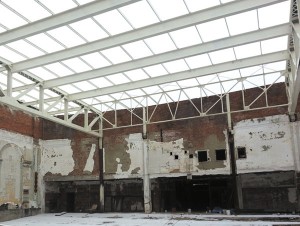The Rivoli Theatre has been part of the east side community since it was built in 1927 — a place to go for movies, concerts, and to hang out with friends. Once a beautiful Spanish Mission Revival theatre that hosted first-run films and seated 1,500, the theatre at 3155 East 10th St. was designed for movies and for stage productions. However, after changing ownership several times over the years, the theatre fell victim to the big multiplex suburban movie theaters growing in popularity in the 70s and 80s. When the Rivoli closed in 1992, it became an empty reminder of what once was a thriving, vital part of Indianapolis.
Recently announced new reuse plans for the Rivoli have made it into a new symbol: one of positive creativity and collaboration to revitalize the near eastside. Jim Kelly, the president of the Rivoli Center for the Performing Arts, Inc., is excited about the Rivoli Reuse Plan put forward recently by the board. “This Reuse Strategic Plan comes from talking with about 20 arts groups about what they need by way of office, studio and storage space. We talked to other theatres in the area. We have about 27,000 square feet of space that can be used after construction and renovation.”
Working with the East 10th Street Civic Association, the organization will be targeting arts groups to establish headquarters in the Rivoli — dance, theatre, the visual arts, and more — at very competitive rents. The reuse would include performance space, seating for 700 or so for performances, as well as offices and storage. The reuse plan also includes the Dearborn Building next door to the Rivoli, which is owned by the East 10th Street Civic Association and would undergo redevelopment as well. “This area is a prime area for redevelopment. We’re in a Promise Zone, and there has been a turnaround going on for the past several years.”
“We are going to focus on creating a modern center for the arts, entertainment, and education,” Kelly stressed. Part of the Rivoli Theatre’s roof will require reconstruction, and other repairs will also be needed. Kelly said that the building will require “selective demolition” inside, followed by reconstruction with steel beams.
“Depending on how you want to develop it, on the low side we need to raise $5-$8 million,” Kelly said. “For about $14 million, we would have all the bells and whistles, maintenance for a year, state-of-the-art sound and video systems.”
Once funding is secured, the reconstruction can begin. The Rivoli project is in the middle of the federal Promise Zone, which Kelly notes will make fundraising and grants easier to get. The plan is to create open space, then secure tenant leases and build offices and storage to suit their needs inside. “We have had high interest from a number of organizations,” Kelly said, “and four tenants paying a competitive rent should be able to sustain the Rivoli for years.”
Creating a financially viable plan for a building that has been virtually empty for two decades is a daunting task, but Kelly believes that with the community rebuilding around the Rivoli, residents moving into the neighborhood will be eager to have an arts center they can walk or bike to. He also believes residents want to get involved in rescuing a part of the history of the east side. The Rivoli Center for the Performing Arts organization meets the first Wednesday of every month at the Chase Near Eastside Legacy Plaza at 7 p.m. for a public meeting. Membership in the organization is $25 yearly — membership fees help pay for insurance and maintenance on the property and larger donations are always welcome. Visit www.rivolitheatre.org or find them on Facebook at IndyRivoli.



